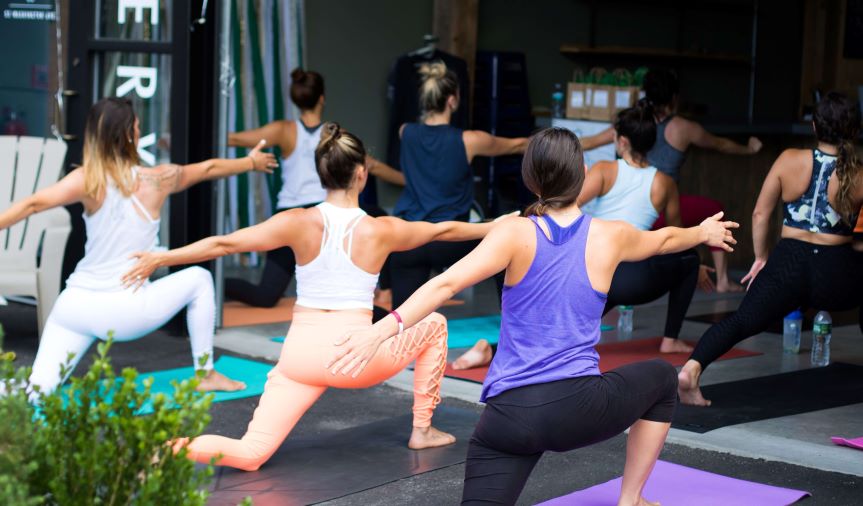How can group physical activity and team sports benefit our mental wellbeing?

October 26 2021
KCL’s Professor Brendon Stubbs hosted a talk that discussed a recent randomised control trial of participants taking part in ASICS Movement for Mind programme – those who took part in some physical activity reported wellbeing gains during the trial.
Stubbs is among countless academic researchers whose work has shown the clear causational benefits of physical activity on mental wellbeing. Regular exercise is known to aide sleep, and improve self-esteem, productivity and resilience. This is why many GPs recommend exercise as part of efforts to improve low mood concerns, stress, anxiety, and depression.
The talk highlighted how exercising together with other people can have additional benefits. While some regular physical activity helps to improve mood, doing so with others or in a community setting such as gym class, can provide a supportive community, help with motivation and improve self-esteem.
Using physical activity to self-manage mental wellbeing
Our wellbeing can change and fluctuate, influenced by both our inner world and external pressures. Work or study stress, financial worries and physical illness can all play a part. Exercise is a well-known and important part of self-managing your mental wellbeing, even, and perhaps especially, during times of high stress.
Dr Tim Rogers, a Consultant Sports Psychiatrist and Togetherall’s Clinical Director, believes in the power of exercise for positive mental wellbeing. “Physical activity plays a part in both preventing and treating depression,” says Rogers. “Avoiding being sedentary is key for all of us, as one part of promoting the best mental and physical health we can have. Even small increases in physical activity can have powerful benefits for how we feel.”
Brain chemistry has a role to play; physical activity triggers a release of dopamine and serotonin to boost the mood and lowers production levels of the stress hormone cortisol. The Department of Health’s publication shown that adults who participate in daily physical activity saw a 20% to 30% lower risk of depression and dementia.
Exercise can be low-cost, and fit in around different schedules, making it an empowering outlet for mental wellbeing – either alone, or alongside other treatments. “We can see movement as medicine and feel good about having invested that in ourselves,” says Rogers.
Low mood, low motivation
While many people accept the positive link between physical activity and improved mental wellbeing, it can be hard to get motivated when experiencing prolonged low mood.
A potential challenge that arises, is staying motivated, especially when experiencing low self-esteem or going through a difficult time. One recent study attempted to investigate how sedentary working during the pandemic has exacerbated the negative feedback loop of decreased exercise, low mood, and low motivation.
Conversely, an improvement in mood can increase the motivation needed to take part in sustained physical activity. Measures to address mood can provide the motivation needed to get you moving. So, mental health and physical activity have a symbiotic relationship and can influence each other. The key is to take the first step to improve mood, physical activity, or ideally, both.
One motivator can be encouragement from peers. Group exercise – whether it’s team sports or simply having a gym buddy – can not only motivate people to start and continue exercise, but also provides a supportive community, that can mitigate any anxieties about exercise, including low self-esteem.
Togetherall’s member resource, ‘Get Physical’ highlights some of the benefits of shared physical activity:
“Working out with others can encourage people to support each other. Exercising together can also feel more of a commitment, which provides an extra incentive to stick with it. For some there’s also an element of healthy competition, which can spur them on to achieve more.”
Community: strengthening both physical and mental wellbeing
Various factors contribute to our wellbeing including an ‘individuals’ ability to develop their potential, work productively and creatively, build strong relationships with others and contribute to their community’. Social connection is inherently part of wellbeing, so combining the benefits of activity with community can increase the mental wellbeing benefits exponentially.
This can be seen in sports teams, golf clubs, walking groups, and most notably in gyms. Tim finds that “being active as part of a team brings belonging and social support, as well as just being fun”.
Many health clubs try to foster an added layer of support based on an inclusive atmosphere and shared achievement in reaching a goal with help from others. This can promote self-growth and a sense of identity. Hutter (2017) has shown the mental health benefits of active participation in a sports club for everyone including younger people and dementia patients: “Playing sport in a club has general psychosocial benefits – that is also a unique feature of a group activity.”
The winning combination of physical activity and community support
Physical activity is one of the great ways that people can self-manage their wellbeing, and is often suggested as a key component of any advice to improve mental health. Even though any activity can be beneficial to mental wellbeing, finding ways to be active with others – whether that’s walking with friends, getting to know gym regulars or signing up for a Zumba class – can help people feel a sense of community which compounds the mental health benefits of exercise.








